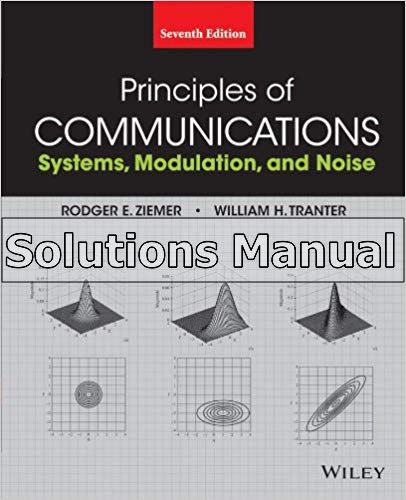Principles of Communications 7th Edition Ziemer Solutions Manual
$26.50$50.00 (-47%)
Principles of Communications 7th Edition Ziemer Solutions Manual.
You may also like
Instant download Principles of Communications 7th Edition Ziemer Solutions Manual pdf docx epub after payment.

Product Details:
- ISBN-10 : 1118078918
- ISBN-13 : 978-1118078914
- Author:
Table of contents:
- Chapter 1: Introduction
- 1.1 The Block Diagram of a Communication System
- 1.2 Channel Characteristics
- 1.2.1 Noise Sources
- 1.2.2 Types of Transmission Channels
- 1.3 Summary of Systems-Analysis Techniques
- 1.3.1 Time and Frequency-Domain Analyses
- 1.3.2 Modulation and Communication Theories
- 1.4 Probabilistic Approaches to System Optimization
- 1.4.1 Statistical Signal Detection and Estimation Theory
- 1.4.2 Information Theory and Coding
- 1.4.3 Recent Advances
- 1.5 Preview of This Book
- Further Reading
- Chapter 2: Signal and Linear System Analysis
- 2.1 Signal Models
- 2.1.1 Deterministic and Random Signals
- 2.1.2 Periodic and Aperiodic Signals
- 2.1.3 Phasor Signals and Spectra
- 2.1.4 Singularity Functions
- 2.2 Signal Classifications
- 2.3 Fourier Series
- 2.3.1 Complex Exponential Fourier Series
- 2.3.2 Symmetry Properties of the Fourier Coefficients
- 2.3.3 Trigonometric Form of the Fourier Series
- 2.3.4 Parseval?s Theorem
- 2.3.5 Examples of Fourier Series
- 2.3.6 Line Spectra
- 2.4 The Fourier Transform
- 2.4.1 Amplitude and Phase Spectra
- 2.4.2 Symmetry Properties
- 2.4.3 Energy Spectral Density
- 2.4.4 Convolution
- 2.4.5 Transform Theorems: Proofs and Applications
- 2.4.6 Fourier Transforms of Periodic Signals
- 2.4.7 Poisson Sum Formula
- 2.5 Power Spectral Density and Correlation
- 2.5.1 The Time-Average Autocorrelation Function
- 2.5.2 Properties of R (?)
- 2.6 Signals and Linear Systems
- 2.6.1 Definition of a Linear Time-Invariant System
- 2.6.2 Impulse Response and the Superposition Integral
- 2.6.3 Stability
- 2.6.4 Transfer (Frequency Response) Function
- 2.6.5 Causality
- 2.6.6 Symmetry Properties of H (f)
- 2.6.7 Input-Output Relationships for Spectral Densities
- 2.6.8 Response to Periodic Inputs
- 2.6.9 Distortionless Transmission
- 2.6.10 Group and Phase Delay
- 2.6.11 Nonlinear Distortion
- 2.6.12 Ideal Filters
- 2.6.13 Approximation of Ideal Lowpass Filters by Realizable Filters
- 2.6.14 Relationship of Pulse Resolution and Risetime to Bandwidth
- 2.7 Sampling Theory
- 2.8 The Hilbert Transform
- 2.8.1 Definition
- 2.8.2 Properties
- 2.8.3 Analytic Signals
- 2.8.4 Complex Envelope Representation of Bandpass Signals
- 2.8.5 Complex Envelope Representation of Bandpass Systems
- 2.9 The Discrete Fourier Transform and Fast Fourier Transform
…
People Also Search:
principles of communications systems modulation and noise
principles of communications satellites
principles of communications satellites pdf
principles of communication activity
principles of animal communication
what are the principles of effective communication
what are the principles of effective written business communications
what are the principles of integrated marketing communications
principles and applications of optical communications












